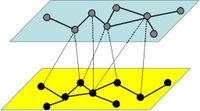A comprehensive analysis of infection dynamics on two-layer interconnected networks reveals crucial insights for epidemic control and social phenomenon understanding. Employing the susceptible-infected-susceptible (SIS) model, researchers explored how various parameters influence the spread of infections across layers designed as small-world networks. The study offers significant findings and implications for managing disease outbreaks effectively.
In recent research that delves into the dynamics of infection spread in networks, a two-layer interconnected model was established to enhance understanding of epidemic control strategies. The layers of the model were constructed as small-world networks, a class of networks characterized by high clustering and short average path lengths. Using the classic susceptible-infected-susceptible (SIS) model, investigators analyzed how different intra-layer and inter-layer parameters impact the spread of infections across the network.
The study's authors highlighted that the interaction between these parameters significantly affects the infection dynamics. As the infection rates within the layers (denoted as bB for layer A and bA for layer B) and the inter-layer infection rates weigh heavily on the interaction between the two layers, an increase in these parameters correlates with a greater final infection proportion. The research indicates that a faster infection spread is observed alongside these increases, shedding light on the intricacies of disease propagation.
The research methodology included developing governing equations to represent the infection state proportions for each layer and validating the existence of steady solutions—analyzing infection proportions as the system evolves. The authors applied numerical methods, particularly the 4th-order Runge-Kutta method, to track the changes over time effectively and to analyze how quickly infections spread within these interconnected networks.
Furthermore, an interesting finding presented in the study concerns the recovery parameters. The model reveals that there exists a maximum value for the use of recovery rates, where the contributions of infection-promoting parameters and recovery rates would balance. When recovery rates exceed this threshold, the potential for infection growth diminishes, indicating that stronger recovery leads to lower infection outcomes.
As the research probes deeper, it considers disparities in the scales of the two layers. The authors found that when the size of one layer is larger than another, the smaller layer demonstrates increased sensitivity to changes in intra-layer parameters. This insight lays grounds for further understanding of how different networks, such as human and animal interactions in disease contexts, can inform public health strategies in real-world scenarios.
A crucial aspect of the investigation focused on establishing characteristic times to infection. This metric defines how long it takes for infections to reach 99% of their steady-state proportions across the two layers. The analysis indicates significant differences based on the configuration of the two-layer networks and the parameters set for transmission rates.
In summarizing the findings, the research illustrates that both intra-layer and inter-layer transmission rates can considerably influence the infection dynamics, reaffirming the importance of interconnected systems in understanding complex behaviors in epidemiology. As elucidated by the authors of the article, "the intra-layer parameters significantly influence the infection dynamics. As the intra-layer parameters increase, the final infection proportions in a layer will increase and the duration time for a layer to reach this state will decrease."b
Overall, this comprehensive research provides valuable guidance for a range of fields from epidemiology to social network analysis. By advancing the understanding of spreading dynamics through the lens of complex networks, it highlights the potential for optimizing disease management strategies in epochal public health challenges. Notably, as the researchers conclude, observations and modeling derived from these findings can pave the way for practical applications in addressing real-world epidemic crises, enhancing the frameworks we have for infectious disease control.




